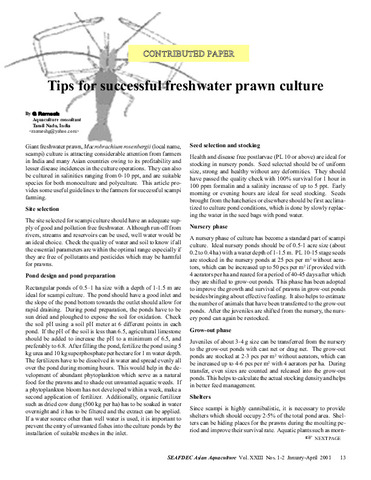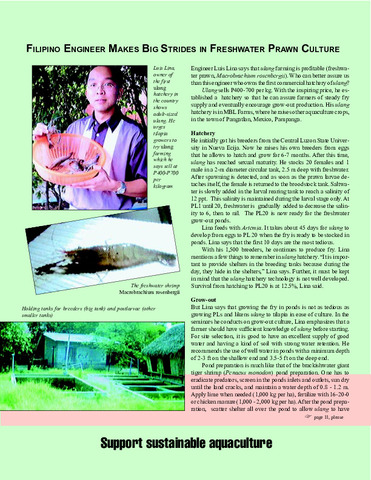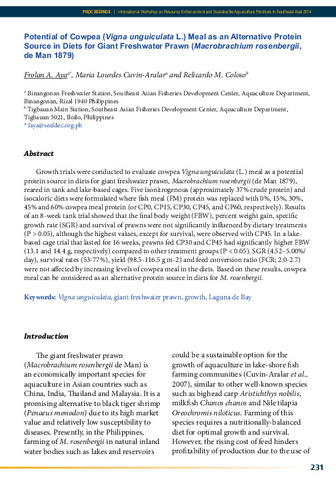Comparative morphology and function of feeding appendages in food intake behaviour of the whiteleg shrimp, Litopenaeus vannamei, and the giant freshwater prawn, Macrobrachium rosenbergii
Share
| dc.contributor.author | Kawamura, Gunzo | |
| dc.contributor.author | Bagarinao, Teodora | |
| dc.contributor.author | Seniman, Nur Syallinaz | |
| dc.contributor.author | Yong, Annita Seok Kian | |
| dc.contributor.author | Lim, Leong-Seng | |
| dc.date.accessioned | 2024-11-12T03:07:14Z | |
| dc.date.available | 2024-11-12T03:07:14Z | |
| dc.date.issued | 2018-12-04 | |
| dc.identifier.citation | Kawamura, G., Bagarinao, T. U., Seniman, N. S., Yong, A. S.-K., & Lim, L.-S. (2018). Comparative morphology and function of feeding appendages in food intake behaviour of the whiteleg shrimp, Litopenaeus vannamei, and the giant freshwater prawn, Macrobrachium rosenbergii. Borneo Journal of Marine Science and Aquaculture (BJoMSA), 2, 26–39. https://doi.org/10.51200/bjomsa.v2i0.1263 | en |
| dc.identifier.issn | 2600-8882 | |
| dc.identifier.uri | http://hdl.handle.net/10862/6567 | |
| dc.description.abstract | Combining feeding appendage morphology and behavioural observation of the motion pattern of the feeding appendages clarified many aspects underlying the feeding processes of the giant freshwater prawn (Macrobrachium rosenbergii) and the marine whiteleg shrimp (Litopenaeus vannamei) in aquaria. The food intake behaviour was video recorded during eating pellet food, pieces of fresh squid and fish. While M. rosenbergii took pellet one by one, L. vannamei picked up many pellets at one time and held them at the mouth with the 3rd maxilliped endopods and the 1st walking legs. Both species used the right chelate walking legs rather than the left walking legs to pick up the food. The 3rd walking legs of L. vannamei were longest and heaviest among the chelate walking legs but their major role was not for feeding but for feeding contests aggression. While M. rosenbergii easily crunched pellets by the mandibles, L. vannamei did not crunch pellets due to the softer and not strong mandibles and frequently spat out them, indicating that the present hard pellets are not suitable for L. vannamei. Both species kept a piece of elastic fresh squid or fish flesh at the mouth and tore the food into small pieces with the help of repeated pulling down motion of the 3rd maxilliped endopods. However, the mandible teeth of the two spices were not sharp enough to gnaw off the fibrous muscle in one bite. The 2nd and 3rd maxilliped endopods were used for holding food at the mouth and did not contribute to mastication of food. The 2nd and 3rd maxilliped exopods exhibited the horizontal fanning motion, which a unidirectional water flow moving backwards in the gill chamber (visualized with milk). The maxilliped exopods were found to contribute not to feeding but ventilation. Based on the results obtained, development of softer pellets was recommended for L. vannamei. | en |
| dc.language.iso | en | en |
| dc.publisher | Universiti Malaysia Sabah (UMS) | en |
| dc.relation.uri | https://jurcon.ums.edu.my/ojums/index.php/BJoMSA/article/view/1263/977 | en |
| dc.subject | Macrobrachium rosenbergii | en |
| dc.subject | Penaeus vannamei | en |
| dc.title | Comparative morphology and function of feeding appendages in food intake behaviour of the whiteleg shrimp, Litopenaeus vannamei, and the giant freshwater prawn, Macrobrachium rosenbergii | en |
| dc.type | Article | en |
| dc.citation.volume | 2 | en |
| dc.citation.spage | 26 | en |
| dc.citation.epage | 39 | en |
| dc.citation.journalTitle | Borneo Journal of Marine Science and Aquaculture (BJoMSA) | en |
| dc.subject.asfa | shrimp culture | en |
| dc.subject.asfa | aquaculture | en |
| dc.subject.asfa | feeding experiments | en |
| dc.subject.asfa | feeding habits | en |
| dc.subject.asfa | pelleted feeds | en |
| dc.subject.asfa | morphology | en |
| dc.identifier.essn | 2600-8637 | |
| dc.identifier.doi | 10.51200/bjomsa.v2i0.1263 | |
| dc.subject.scientificName | Macrobrachium rosenbergii | en |
| dc.subject.scientificName | Litopenaeus vannamei | en |
| dc.subject.scientificName | Penaeus vannamei | en |
| local.subject | Mouthparts | en |
| local.subject | Walking legs | en |
| local.subject | Video observation | en |
| local.subject | Ventilation | en |
| local.subject | Pellet food | en |
Files in this item
| Files | ขนาด | รูป | View |
|---|
รายการนี้ปรากฏใน (s)
-
AQD Journal Articles [1230]
These papers were contributed by AQD staff to various national and international journals



